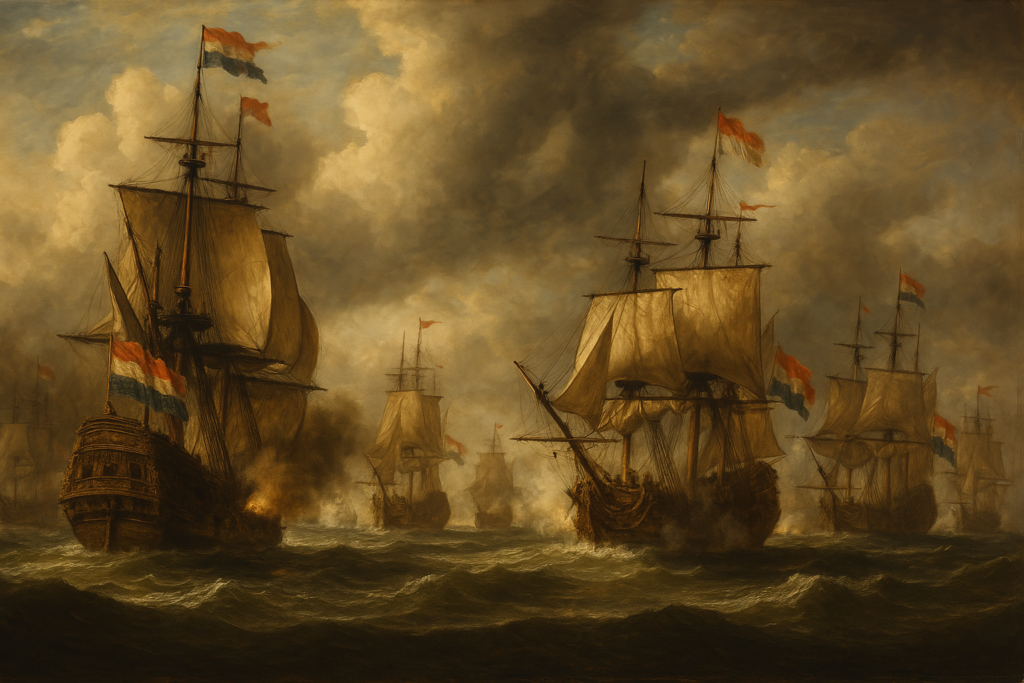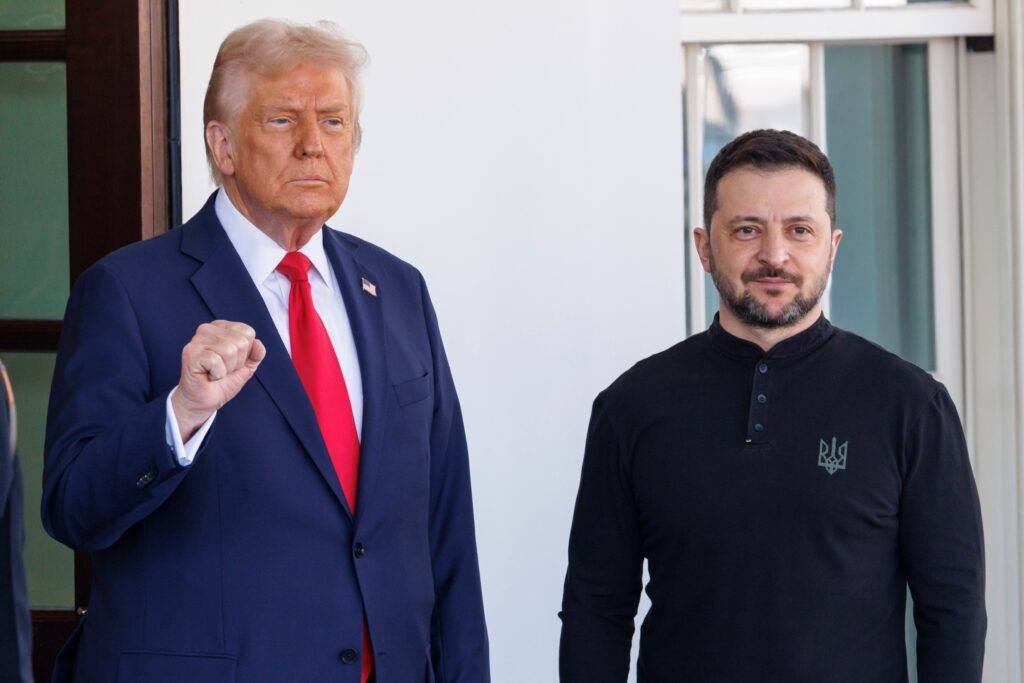The USA’s ‘Liberation Day’ tariffs are a recurring pattern throughout history. These trade barriers have struck the defence industry hard, disrupting imports and exports. In 2024, American defence exports were valued at over $300 billion. Nations have long used trade barriers as instruments of power, and in some cases, these economic skirmishes have spiralled into full-scale military confrontations.
On 2 April 2025, U.S. President Donald Trump declared what he called “Liberation Day” – rolling out sweeping new tariffs aimed squarely at America’s main trading partners. Speaking in the White House Rose Garden, Trump called it the country’s economic “declaration of independence”. He slapped a 10 percent baseline tariff on all imports into the U.S., with even steeper rates for specific countries – including close allies like Mexico, Taiwan, South Korea, Japan, and several European nations.
Trump brandished a poster of so-called “reciprocal tariffs”, showing a 34 percent rate on Chinese imports and 20% on goods from the EU – figures he said matched the barriers those regions impose on U.S. products. His aim, he claimed, was to “get even” with countries running big trade surpluses with the U.S. by mirroring their tariffs.
But rather than isolating China, the move appeared to push its neighbours – even long-standing U.S. allies – towards Beijing. Reports emerged of early talks between China, Japan, and South Korea on a joint response. Some analysts reckoned Trump was using the tariffs as leverage for a grand deal with China – tying together trade, Taiwan, and other flashpoints in one high-stakes showdown.
Global Supply Chain of the US Defence Industry
The media’s spotlight has been on cars, but defence also depends on a tangled global supply chain—electronics, raw materials, subassemblies. New tariffs are driving up import costs, raising expenses for U.S. defence contractors. This means pricier deals for the Pentagon and delays in gear production and upkeep.
In 2024, U.S. arms sales to foreign governments hit $318.7 billion—up 29 percent. Demand spiked as countries restocked amid rising global tensions. The U.S. grabbed 43 percent of global arms exports.
But tariffs could backfire. Hit countries might slap their own tariffs on U.S. defence exports, denting competitiveness, exports, and profits.
Despite being a major exporter, the U.S. still imports key defence components. Tariffs on allies like the EU (20%) and Japan (24%) will push up costs for U.S. firms relying on those parts.
Triggering War Since Ancient Greece
Trade restrictions and embargos have long been capable of triggering actual war. One of the earliest recorded trade conflicts occurred in ancient Greece. In 432 BC, Athens issued the Megarian Decree, imposing sanctions that banned Megara from Athenian markets. Sparta viewed this economic punishment as intolerable; when Athens refused to revoke the decree, Sparta declared war – igniting the Peloponnesian War.

During the Age of Sail, trade was entwined with national power, leading to many so-called “trade wars.” In the 17th century, the rising Dutch Republic and England clashed over global commerce. The First Anglo-Dutch War (1652–1654) was caused by disputes over trade and navigation rights; it began with English attacks on Dutch merchant ships and soon escalated to naval battles. Subsequent Anglo-Dutch Wars also centred on control of trade routes and commercial dominance.
In the East Indies, competition for the spice trade turned violent in 1621 when the Dutch, seeking a monopoly on nutmeg, perpetrated the Massacre of the Bandanese – an extreme case of a trade dispute leading to conquest and bloodshed.
American Economic Revolution
The U.S. War of Independence wasn’t just about liberty – it had clear economic roots. Britain enforced tight trade controls, protecting its own merchants by limiting colonial exports and imports. For instance, the British crown granted monopolies over lucrative trades like fur, shutting out colonial traders. Laws like the Navigation Acts forced Americans to ship goods only via British vessels, often at worse prices. Small colonial business owners, artisans, and farmers saw this as economic strangulation. Tensions rose further with direct taxes – like the Stamp Act and Tea Act – seen as economic exploitation without representation. The result: trade grievances helped fuel the revolution.
Tariff Wars and Opium
The 1800s saw trade frictions both between and within empires. After the Napoleonic Wars, Britain and the United States tussled over trade access. British efforts to bar U.S. commerce with Napoleonic Europe – including naval blockades and tariffs – contributed to the outbreak of the War of 1812 between Britain and America.
A different kind of trade conflict exploded in East Asia. The First Opium War (1839–1842) erupted after China’s Qing Dynasty outlawed the opium trade and seized opium stocks from British merchants. In response, British trading interests lobbied London to use force. The result was a British naval campaign to compel China to reopen trade, an early example of a tariff dispute (in this case, a ban on opium) escalating into war.
The Opium War ended with China ceding Hong Kong and granting trade concessions – a stark illustration of a trade war resolved only by military victory.
Civil Trade War
Tariffs and trade policy played a major role in the lead-up to the U.S. Civil War. The industrial North favoured high tariffs to protect its factories from European imports, while the agricultural South, reliant on exporting cotton and importing goods, pushed for low tariffs. Southern leaders saw Northern-backed tariff laws as unfair and economically damaging. The conflict over trade and tariffs fed into the wider clash over states’ rights and slavery. The Southern economy’s dependence on free trade became one more dividing line in a war that was both moral and economic.
Economic Competition and the Great War
The First World War wasn’t triggered by a classic trade war, but economic rivalries and trade tensions helped stoke the fire. In the decades before 1914, Britain, the world’s top empire, was increasingly challenged by the rapid industrial rise of Germany. Germany’s push to expand its navy and overseas markets threatened British dominance in global trade and shipping lanes. Trade competition in Africa, Asia, and the Balkans intensified as empires clashed over resources, colonies, and access to markets.
Protectionist policies also played a role. Germany’s tariffs on British goods and aggressive industrial expansion fuelled British suspicion. Meanwhile, economic nationalism surged across Europe. Countries built up arms and imposed tariffs to protect industries, creating a climate of rivalry rather than cooperation. After war broke out, trade became a weapon. Britain imposed a naval blockade on Germany, aiming to choke off supplies of food, fuel, and raw materials. In response, Germany launched unrestricted submarine warfare against Allied and neutral shipping. The war became a brutal form of economic strangulation – with blockades, rationing, and resource grabs shaping both military and civilian life.
Depression Turned to Protectionism
The early 20th century continued to witness trade conflicts, though new international institutions later helped mitigate them. In the 1930s, amid the Great Depression, countries turned to protectionism. The United States passed the Smoot–Hawley Tariff Act (1930), imposing sweeping tariffs on imports. This provoked retaliation from many nations and a global trade war, worsening economic conditions worldwide. While Smoot–Hawley’s trade war did not directly cause a war, it is often cited as deepening the economic desperation that preceded World War II. In Europe, an unusual trade dispute known as the Anglo-Irish Trade War (1932–1938) saw the Irish Free State and Britain levy duties on each other’s goods over a financial quarrel. The “Economic War,” as it was called, was damaging but remained confined to tariffs and boycotts. By 1938, both sides negotiated a settlement lifting the punitive duties, demonstrating that even bitter trade wars can be resolved peacefully through diplomacy.
Seeking Economic Self-sufficiency
While the Second World War was primarily driven by territorial ambition, ideology, and unresolved issues from WWI, trade tensions and economic grievances played a background role — especially in Europe. Germany, under Hitler, railed against the post-WWI economic order, which included harsh reparations, restricted trade, and limited access to raw materials.
Germany’s Nazi regime sought economic self-sufficiency (autarky)and expanded aggressively to secure resources—especially in Eastern Europe. Hitler’s plans for Lebensraum were partly economic: controlling farmland, oil, and raw materials to break dependence on trade with hostile powers. Similarly, Mussolini’s Italy invaded Ethiopia in 1935 partly to secure markets and resources, but sanctions by the League of Nations backfired and pushed Italy closer to Nazi Germany. Britain and France maintained empires with captive markets, but this only increased German resentment. By the late 1930s, Europe was split into hostile economic zones, with limited trade and rising tariffs. The war, once it began, again saw trade used as a weapon—blockades, strategic bombing of factories, and rationing became tools of total warfare.
The Trade Trigger Behind Pearl Harbor: Oil
Japan’s empire needed massive amounts of oil, rubber, and metals to fuel its military expansion across Asia. But it lacked natural resources and relied heavily on imports— especially from the U.S.
In mid-1941, after Japan invaded French Indochina, the U.S., Britain, and the Netherlands froze Japanese assets and, crucially, cut off oil exports. The American oil embargo was a direct economic chokehold: Japan got about 80 percent of its oil from the U.S.. Without oil, its navy and air force would grind to a halt within months. Faced with the prospect of strategic collapse, Japan decided to secure resource-rich territories in Southeast Asia—like the Dutch East Indies (Indonesia) for oil. But to do that, it had to neutralize the U.S. Pacific Fleet, which is why they launched the preemptive strike on Pearl Harbor.
Building Economic War Lines
Trade became central to rebuilding and securing alliances after WWII — but the methods split along Cold War lines. Washington used economic aid and trade to forge a Western alliance. The 1948 Marshall Plan pumped over $12 billion – roughly $150 billion today –into war-torn Europe. It wasn’t just humanitarian—America demanded that recipients liberalise trade, align economically with the West, and reject communism. U.S. trade policy helped form NATO and laid the groundwork for European integration. American access to European markets and political loyalty went hand in hand.
The USSR took a different path, building a bloc of satellite states with centralised trade planning. The Council for Mutual Economic Assistance (Comecon) was formed in 1949 to coordinate trade within the Eastern Bloc. Trade was politically controlled, and aligned nations like East Germany, Poland, and Czechoslovakia exchanged goods under strict quotas. This “closed loop” trade system bound the economies to Moscow but stifled competition and innovation over time.
Voluntary Peacetime Export Restraints
After World War II, frameworks like the General Agreement on Tariffs and Trade (1947) and later the World Trade Organization (WTO) were established to handle trade disputes and prevent them from escalating. Major trade tensions still occurred – for example, in the 1980s U.S.–Japan trade war, the United States accused Japan of unfair trade practices in cars and electronics. Washington imposed quotas and threatened tariffs, while Japan negotiated voluntary export restraints and market-opening measures. Over the decade, more than 100 bilateral agreements were reached to defuse the conflict:
This intense trade confrontation did not turn into military conflict, partly because both nations were close allies and found diplomatic solutions. Trade wars in the late 20th century tended to be contained by negotiation and international rules, avoiding the armed clashes that marked earlier eras.
Post–Cold War: Re-learning How to Weaponise Trade
In the post-Cold War glow, the WTO was meant to settle disputes. Trade spats flared — over bananas, steel, and subsidies — but were mostly managed within legal frameworks. The U.S. and EU bickered but rarely broke the system.
China’s meteoric growth and state-backed industries led to accusations of dumping, IP theft, and unfair practices. In response, the U.S. under Trump launched a full-blown tariff war in 2018, targeting hundreds of billions in Chinese goods. China retaliated. Supply chains were shaken. Allies like the EU and Canada were caught in the crossfire.
COVID-19 exposed how fragile global supply chains were. Then Russia’s invasion of Ukraine showed how trade could be weaponised—sanctions, gas pipelines, grain exports. Economic blocs hardened. The U.S. doubled down on protecting strategic sectors like semiconductors and clean tech — often at China’s expense. Europe followed suit.
China Forging New Alliances
Amidst President Trump’s sweeping 2025 tariffs, China is seizing the opportunity to strengthen its global influence through strategic trade partnerships. In response to these U.S. measures, China has intensified its Belt and Road Initiative (BRI), offering infrastructure investments and trade deals to countries alienated by U.S. protectionism. This approach not only counters U.S. economic aggression but also positions China as a champion of free trade, appealing to nations seeking stable economic relations. Furthermore, China is collaborating with affected nations to present a united front against U.S. tariffs. Notably, China, Japan, and South Korea have initiated talks to coordinate their responses, aiming to mitigate the impact of U.S. trade policies and enhance regional economic cooperation.
Spiralling Out of Control?
We’re in an age of “de-risking,” not decoupling. The world is no longer heading toward a unified trade system. Instead, it’s splintering into rival economic spheres, with tariffs, export controls, and sanctions used like diplomatic tools—or blunt weapons. Trump’s Liberation Day in April 2025 is a striking modern chapter in this saga. It revives questions that echo through history: Will a trade war lead to a new equilibrium or spiral out of control?
Read More:
- FT: Donald Trump’s beautiful trade war
- Reuters: China, Japan, South Korea will jointly respond to US tariffs, Chinese state media says
- The Times: Trump’s effort to rebalance world trade hits allies as much as China
- Brock University – Danahay, Martin: History shows how a trade war can become a violent conflict
- Reuters: Trump stokes trade war as world reels from tariff shock
- Politico: Trump’s “Liberation Day” is also a test on China
- Livius.org (Jona Lendering): Megarian Decree – trade sanctions before the Peloponnesian War
- Wikipedia: Trade war– Historical examples
- Office of the Historian, U.S. State Dept: Japan, the U.S. and the Road to Pearl Harbor
- Wikipedia: Anglo-Irish Trade War
- PBS NewsHour: Lessons from trade with Japan in the 1980s
- Al Jazeera: Trump announces ‘Liberation Day’ tariffs



